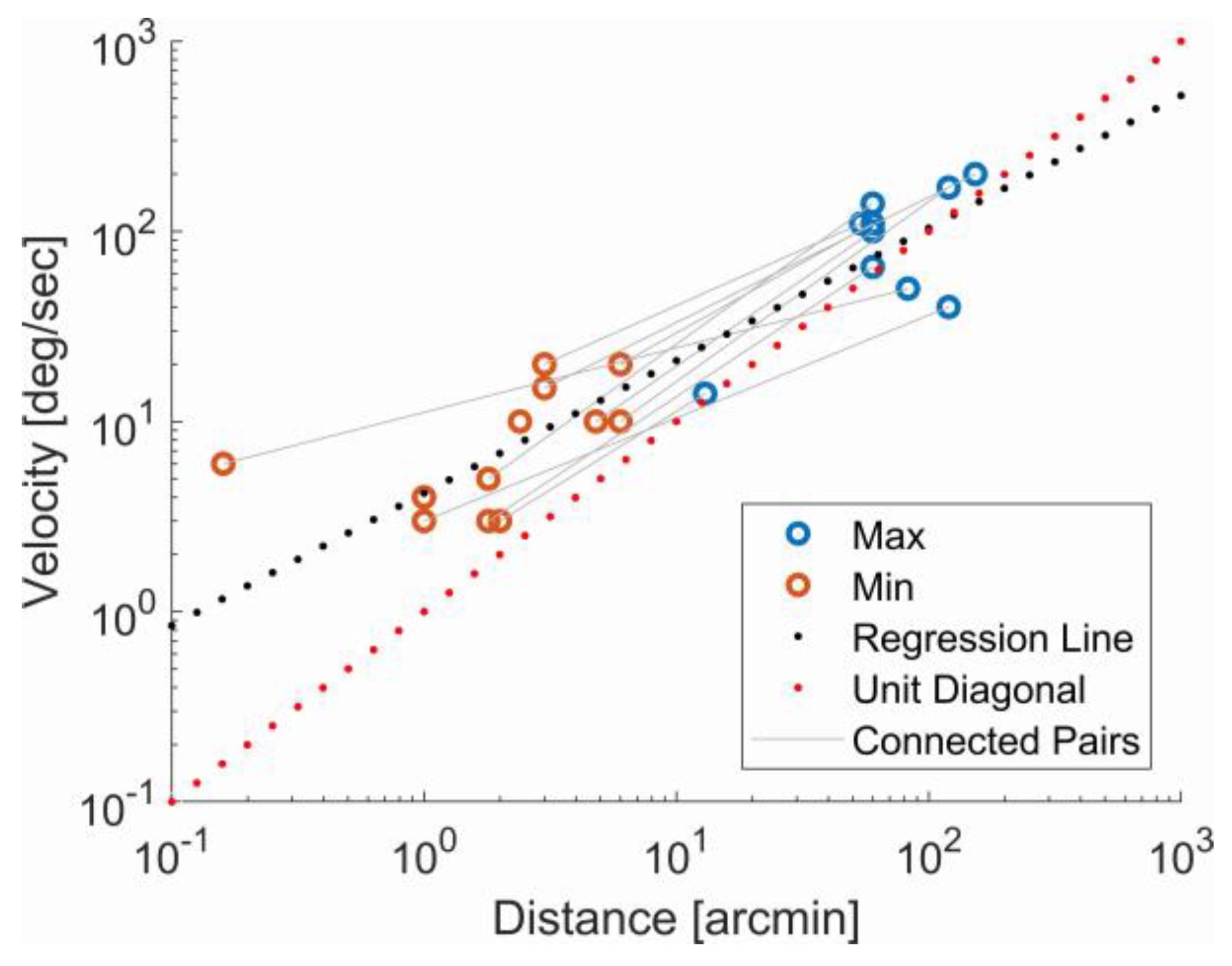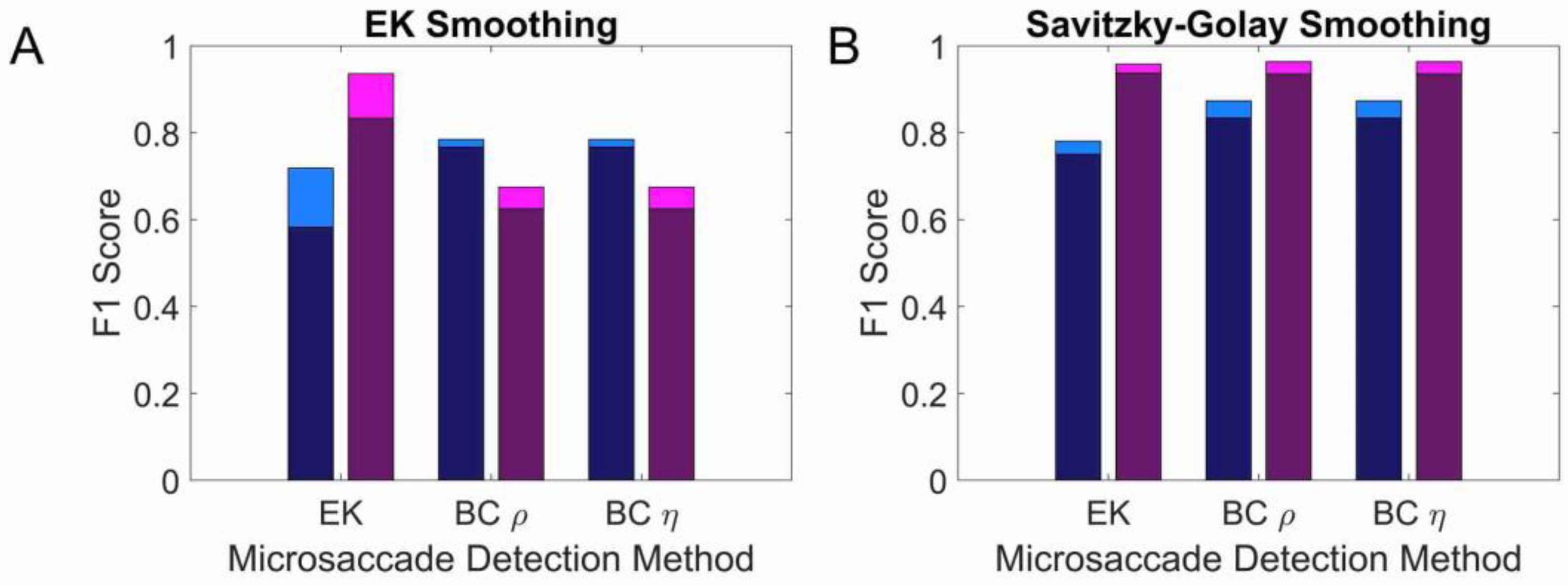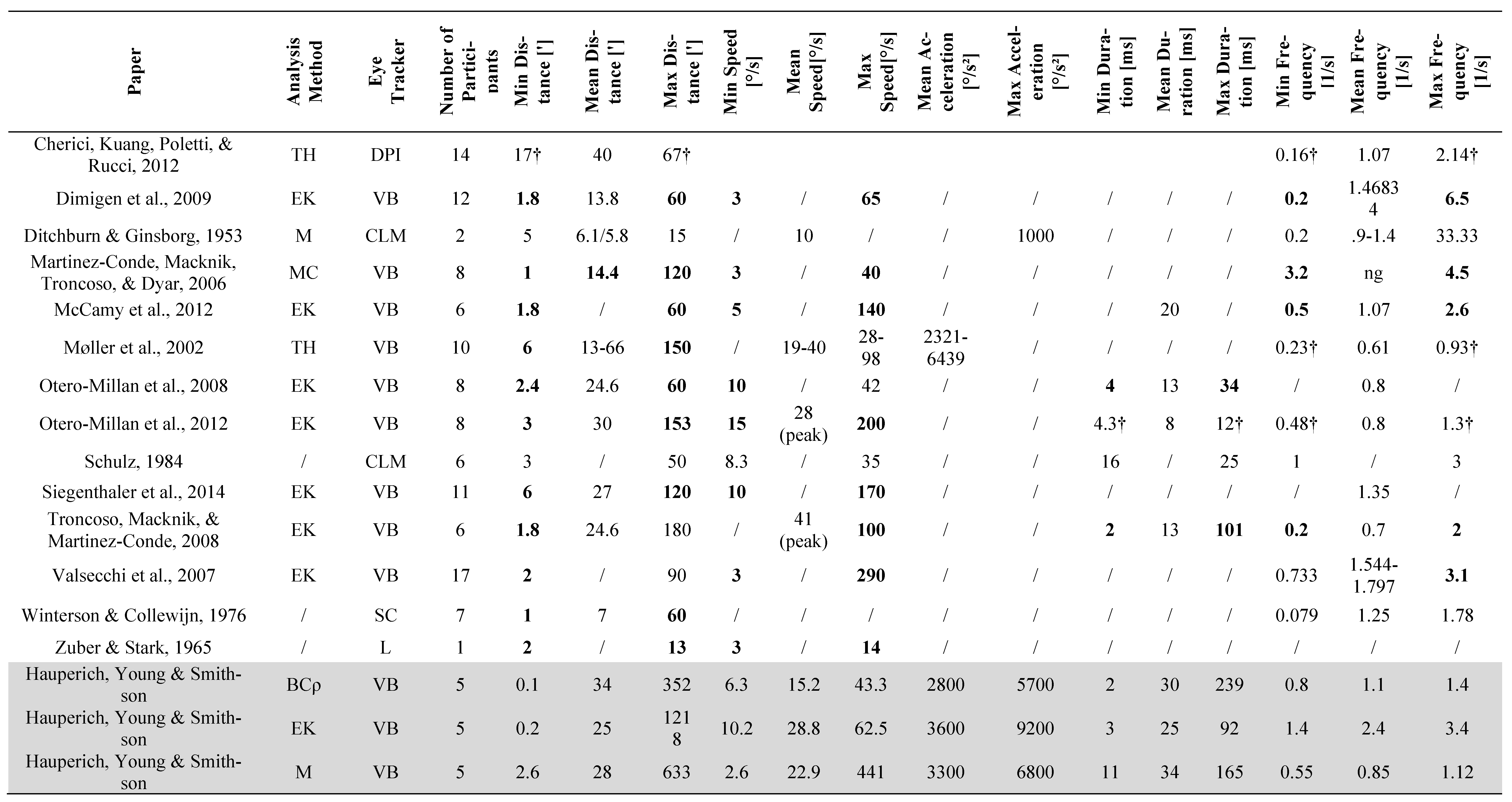What Makes a Microsaccade? A Review of 70 Years of Research Prompts a New Detection Method
Abstract
Introduction
Literature Review
Methods
Results
Discussion
Microsaccade Detection
Data Collection
Participants
Materials
Procedure
Data Analysis
Pre-processing
Manual coding
Automated EK
Automated BC
- Calculate the coefficient of determination (R2) for a moving correlation window between speed for left and right eyes.
- Apply a threshold value to R2; high R2 values identify periods containing a microsaccade.
- Remove the first and last ω/2 samples from a period of above-threshold R2.
Evaluation Metrics

Optimisation
Results
Discussion
General Discussion
Acknowledgments
Conflicts of Interest
References
- Abadi, R. V., and E. Gowen. 2004. Characteristics of saccadic intrusions. Vision Research 44, 23: 2675–2690. [Google Scholar] [CrossRef] [PubMed]
- Armington, J. C., and M. B. Bloom. 1974. Relations between the amplitudes of spontaneous saccades and visual responses. Journal of the Optical Society of America 64, 9: 1263–1271. [Google Scholar] [CrossRef] [PubMed]
- Barlow, H. B. 1952. Eye Movements during Fixation. Journal of Physiology 116, 3: 290–306. [Google Scholar] [CrossRef] [PubMed]
- Barlow, H. B. 1963. Slippage of contact lenses and other artefacts in relation to fading and regeneration of supposedly stable retinal images. Quarterly Journal of Experimental Psychology 15, 1: 36–51. [Google Scholar] [CrossRef]
- Becker, W., and R. Jürgens. 1979. An analysis of the saccadic system by means of double step stimuli. Vision Research 19, 9: 967–983. [Google Scholar] [CrossRef]
- Beeler, G. W. 1967. Visual threshold changes resulting from spontaneous saccadic eye movements. Vision Research 7, 9–10: 769–775. [Google Scholar] [CrossRef]
- Bellet, M. E., J. Bellet, H. Nienborg, Z. M. Hafed, and P. Berens. 2019. Human-level saccade detection performance using deep neural networks. Journal of Neurophysiology 121, 2: 646–661. [Google Scholar] [CrossRef]
- Betta, E., G. Galfano, and M. Turatto. 2007. Microsaccadic response during inhibition of return in a target–target paradigm. Vision Research 47, 3: 428–436. [Google Scholar] [CrossRef]
- Bridgeman, B., and J. Palca. 1980. The role of microsaccades in high acuity observational tasks. Vision Research 20, 9: 813–817. [Google Scholar] [CrossRef]
- Cherici, C., X. Kuang, M. Poletti, and M. Rucci. 2012. Precision of sustained fixation in trained and untrained observers. Journal of Vision 12, 6: 31. [Google Scholar] [CrossRef]
- Collewijn, H., and E. Kowler. 2008. The significance of microsaccades for vision and oculomotor control. Journal of Vision 8, 14: 1–21. [Google Scholar] [CrossRef] [PubMed]
- Cornsweet, T. N. 1956. Determination of the Stimuli for Involuntary Drifts and Saccadic Eye Movements. Journal of the Optical Society of America 46, 11: 987–988. [Google Scholar] [CrossRef] [PubMed]
- Deubel, H., and T. Elsner. 1986. Threshold perception and saccadic eye movements. Biological Cybernetics 54, 6: 351–358. [Google Scholar] [CrossRef] [PubMed]
- Di Stasi, L. L., M. B. Mccamy, A. Catena, S. L. Macknik, J. J. Cañas, and S. Martinez-Conde. 2013. Microsaccade and drift dynamics reflect mental fatigue. European Journal of Neuroscience 38, 3: 2389–2398. [Google Scholar] [CrossRef]
- Dimigen, O., M. Valsecchi, W. Sommer, and R. Kliegl. 2009. Human Microsaccade-Related Visual Brain Responses. Journal of Neuroscience 29, 39: 12321–12331. [Google Scholar] [CrossRef]
- Ditchburn, R. W., D. H. Fender, S. Mayne, and R. M. Pritchard. 1956. A Stabilized Retinal Image of the Iris. Proceedings of the Physical Society 69: 1165–1166. [Google Scholar] [CrossRef]
- Ditchburn, R. W., and B. L. Ginsborg. 1953. Involuntary eye movements during fixation. The Journal of Physiology 119: 1–17. [Google Scholar] [CrossRef]
- Engbert, R. 2006. Microsaccades: a microcosm for research on oculomotor control, attention, and visual perception. In Progress in Brain Research. Vol. 154, pp. 177–192. [Google Scholar] [CrossRef]
- Engbert, R., and R. Kliegl. 2003. Microsaccades uncover the orientation of covert attention. Vision Research 43, 9: 1035–1045. [Google Scholar] [CrossRef]
- Engbert, R., and R. Kliegl. 2004. Microsaccades Keep the Eyes’ Balance During Fixation. Psychological Science 15, 6: 431–436. [Google Scholar] [CrossRef]
- Engbert, R., and K. Mergenthaler. 2006. Microsaccades are triggered by low retinal image slip. Proceedings of the National Academy of Sciences 103, 18: 7192–7197. [Google Scholar] [CrossRef]
- Fang, Y., C. Gill, M. Poletti, and M. Rucci. 2018. Monocular microsaccades: Do they really occur? Journal of Vision 18, 3: 1–14. [Google Scholar] [CrossRef] [PubMed]
- Fried, M., E. Tsitsiashvili, Y. S. Bonneh, A. Sterkin, T. Wygnanski-Jaffe, T. Epstein, and U. Polat. 2014. ADHD subjects fail to suppress eye blinks and microsaccades while anticipating visual stimuli but recover with medication. Vision Research 101: 62–72. [Google Scholar] [CrossRef] [PubMed]
- Gautier, J., H. E. Bedell, J. Siderov, and S. J. Waugh. 2016. Monocular microsaccades are visual-task related. Journal of Vision 16, 3: 37. [Google Scholar] [CrossRef] [PubMed][Green Version]
- Gowen, E., R. V. Abadi, E. Poliakoff, P. C. Hansen, and R. C. Miall. 2007. Modulation of saccadic intrusions by exogenous and endogenous attention. Brain Research 1141, 1: 154–167. [Google Scholar] [CrossRef]
- Haddad, G. M., and R. M. Steinman. 1973. The smallest voluntary saccade: Implications for fixation. Vision Research 13, 6: 1075–1086. [Google Scholar] [CrossRef]
- Hafed, Z. M. 2011. Mechanisms for generating and compensating for the smallest possible saccades. European Journal of Neuroscience 33, 11: 2101–2113. [Google Scholar] [CrossRef]
- Hafed, Z. M., and J. J. Clark. 2002. Microsaccades as an overt measure of covert attention shifts. Vision Research 42, 22: 2533–2545. [Google Scholar] [CrossRef]
- Hipp, J. F., and M. Siegel. 2013. Dissociating neuronal gamma-band activity from cranial and ocular muscle activity in EEG. Frontiers in Human Neuroscience 7: 1–11. [Google Scholar] [CrossRef]
- Hooge, I. T. C., D. C. Niehorster, M. Nyström, R. Andersson, and R. S. Hessels. 2018. Is human classification by experienced untrained observers a gold standard in fixation detection? Behavior Research Methods 50, 5: 1864–1881. [Google Scholar] [CrossRef]
- Ko, H. K., M. Poletti, and M. Rucci. 2010. Microsaccades precisely relocate gaze in a high visual acuity task. Nature Neuroscience 13, 12: 1549–1554. [Google Scholar] [CrossRef]
- Krauskopf, J., T. N. Cornsweet, and L. A. Riggs. 1960. Analysis of Eye Movements during Monocular and Binocular Fixation*. Journal of the Optical Society of America 50, 6: 572–578. [Google Scholar] [CrossRef] [PubMed]
- Laubrock, J., R. Engbert, and R. Kliegl. 2005. Microsaccade dynamics during covert attention. Vision Research 45, 6: 721–730. [Google Scholar] [CrossRef] [PubMed]
- Martinez-Conde, S. 2006. Fixational eye movements in normal and pathological vision. In Progress in Brain Research. Vol. 154, pp. 151–176. [Google Scholar] [CrossRef]
- Martinez-Conde, S., and S. L. Macknik. 2007. Windows on the mind. Scientific American 297, 2: 56–63. Available online: http://www.ncbi.nlm.nih.gov/pubmed/17894173. [PubMed]
- Martinez-Conde, S., S. L. Macknik, and D. H. Hubel. 2000. Microsaccadic eye movements and firing of single cells in the striate cortex of macaque monkeys. Nature Neuroscience 3, 3: 251–258. [Google Scholar] [CrossRef]
- Martinez-Conde, S., S. L. Macknik, X. G. Troncoso, and T. A. Dyar. 2006. Microsaccades Counteract Visual Fading during Fixation. Neuron 49, 2: 297–305. [Google Scholar] [CrossRef]
- McCamy, M. B., J. Otero-Millan, L. L. Di Stasi, S. L. Macknik, and S. Martinez-Conde. 2014. Highly Informative Natural Scene Regions Increase Microsaccade Production during Visual Scanning. Journal of Neuroscience 34, 8: 2956–2966. [Google Scholar] [CrossRef]
- McCamy, M. B., J. Otero-Millan, S. L. Macknik, Y. Yang, X. G. Troncoso, S. M. Baer, and S. Martinez-Conde. 2012. Microsaccadic Efficacy and Contribution to Foveal and Peripheral Vision. Journal of Neuroscience 32, 27: 9194–9204. [Google Scholar] [CrossRef]
- Mihali, A., B. van Opheusden, and W. J. Ma. 2017. Bayesian microsaccade detection. Journal of Vision 17, 1: 13. [Google Scholar] [CrossRef]
- Møller, F., M. L. Laursen, and A. K. Sjølie. 2006. The contribution of microsaccades and drifts in the maintenance of binocular steady fixation. Graefe’s Archive for Clinical and Experimental Ophthalmology 244, 4: 465–471. [Google Scholar] [CrossRef]
- Møller, F., M. L. Laursen, J. Tygesen, and A. K. Sjølie. 2002. Binocular quantification and characterization of microsaccades. Graefe’s Archive for Clinical and Experimental Ophthalmology 240, 9: 765–770. [Google Scholar] [CrossRef]
- Moshel, S., A. Z. Zivotofsky, L. Jin-Rong, R. Engbert, J. Kurths, R. Kliegl, and S. Havlin. 2008. Persistence and phase synchronisation properties of fixational eye movements. European Physical Journal: Special Topics 161, 1: 207–223. [Google Scholar] [CrossRef]
- Nachmias, J. 1961. Determiners of the drift of the eye during monocular fixation. Journal of the Optical Society of America 51, 7: 761–766. [Google Scholar] [CrossRef] [PubMed]
- Nyström, M., R. Andersson, D. C. Niehorster, and I. Hooge. 2017. Searching for monocular microsaccades–A red Hering of modern eye trackers? Vision Research 140: 44–54. [Google Scholar] [CrossRef] [PubMed]
- Nyström, M., D. W. Hansen, R. Andersson, and I. Hooge. 2016. Why have microsaccades become larger? Investigating eye deformations and detection algorithms. Vision Research 118: 17–24. [Google Scholar] [CrossRef]
- Otero-Millan, J., J. L. A. Castro, S. L. Macknik, and S. Martinez-Conde. 2014. Unsupervised clustering method to detect microsaccades. Journal of Vision 14, 2: 18. [Google Scholar] [CrossRef]
- Otero-Millan, J., S. L. Macknik, R. E. Langston, and S. Martinez-Conde. 2013. An oculomotor continuum from exploration to fixation. Proceedings of the National Academy of Sciences 110, 15: 6175–6180. [Google Scholar] [CrossRef]
- Otero-Millan, J., S. L. Macknik, and S. Martinez-Conde. 2012. Microsaccades and Blinks Trigger Illusory Rotation in the “Rotating Snakes” Illusion. Journal of Neuroscience 32, 17: 6043–6051. [Google Scholar] [CrossRef]
- Otero-Millan, J., A. Serra, R. J. Leigh, X. G. Troncoso, S. L. Macknik, and S. Martinez-Conde. 2011. Distinctive Features of Saccadic Intrusions and Microsaccades in Progressive Supranuclear Palsy. Journal of Neuroscience 31, 12: 4379–4387. [Google Scholar] [CrossRef]
- Otero-Millan, J., X. G. Troncoso, S. L. Macknik, I. Serrano-Pedraza, and S. Martinez-Conde. 2008. Saccades and microsaccades during visual fixation, exploration, and search: Foundations for a common saccadic generator. Journal of Vision 8, 14: 21. [Google Scholar] [CrossRef]
- Pastukhov, A., and J. Braun. 2010. Rare but precious: Microsaccades are highly informative about attentional allocation. Vision Research 50, 12: 1173–1184. [Google Scholar] [CrossRef]
- Ratliff, F., and L. A. Riggs. 1950. Involuntary motions of the eye during monocular fixation. Journal of Experimental Psychology 40, 6: 687–701. [Google Scholar] [CrossRef] [PubMed]
- Riggs, L. A., J. C. Armington, and F. Ratliff. 1954. Motions of the retinal image during fixation. Journal of the Optical Society of America 44, 4: 315–321. [Google Scholar] [CrossRef] [PubMed]
- Rolfs, M. 2009. Microsaccades: Small steps on a long way. Vision Research 49, 20: 2415–2441. [Google Scholar] [CrossRef] [PubMed]
- Rolfs, M., R. Kliegl, and R. Engbert. 2008. Toward a model of microsaccade generation: The case of microsaccadic inhibition. Journal of Vision 8, 11: 1–23. [Google Scholar] [CrossRef]
- Rucci, M., and G. Desbordes. 2003. Contributions of fixational eye movements to the discrimination of briefly presented stimuli. Journal of Vision 3, 11: 852–864. [Google Scholar] [CrossRef]
- Rucci, M., and M. Poletti. 2015. Control and Functions of Fixational Eye Movements. Annual Review of Vision Science 1, 1: 499–518. [Google Scholar] [CrossRef]
- Schulz, E. 1984. Binocular micromovements in normal persons. Graefe’s Archive for Clinical and Experimental Ophthalmology 222: 95–100. [Google Scholar] [CrossRef]
- Schweitzer, R., and M. Rolfs. 2019. An adaptive algorithm for fast and reliable online saccade detection. Behavior Research Methods. [Google Scholar] [CrossRef]
- Shelchkova, N., C. Tang, and M. Poletti. 2019. Task-driven visual exploration at the foveal scale. Proceedings of the National Academy of Sciences 116, 12: 5811–5818. [Google Scholar] [CrossRef]
- Siegenthaler, E., F. M. Costela, M. B. Mccamy, L. L. Di Stasi, J. Otero-Millan, A. Sonderegger, and S. Martinez-Conde. 2014. Task difficulty in mental arithmetic affects microsaccadic rates and magnitudes. European Journal of Neuroscience 39, 2: 287–294. [Google Scholar] [CrossRef]
- Snodderly, D. M. 1987. Effects of light and dark environments on macque and human fixation eye movements. Vision Research 27, 3: 401–415. [Google Scholar] [CrossRef] [PubMed]
- St. Cyr, G. J., and D. H. Fender. 1969. The interplay of drifts and flicks in binocular fixation. Vision Research 9: 245–265. [Google Scholar] [CrossRef] [PubMed]
- Steinman, R. M., R. J. Cunitz, G. T. Timberlake, and M. Herman. 1967. Voluntary control of microsaccades during maintained monocular fixation. Science 155, 3769: 1577–1579. [Google Scholar] [CrossRef] [PubMed]
- Steinman, R. M., G. M. Haddad, A. A. Skavenski, and D. Wyman. 1973. Miniature Eye Movement. Science 181, 4102: 810–819. [Google Scholar] [CrossRef]
- Thaler, L., A. C. Schütz, M. A. Goodale, and K. R. Gegenfurtner. 2013. What is the best fixation target? The effect of target shape on stability of fixational eye movements. Vision Research 76: 31–42. [Google Scholar] [CrossRef]
- Troncoso, X. G., S. L. Macknik, and S. Martinez-Conde. 2008. Microsaccades counteract perceptual filling-in. Journal of Vision 8, 14: 1–9. [Google Scholar] [CrossRef]
- Troncoso, X. G., S. L. Macknik, J. Otero-Millan, and S. Martinez-Conde. 2008. Microsaccades drive illusory motion in the Enigma illusion. Proceedings of the National Academy of Sciences 105, 41: 16033–16038. [Google Scholar] [CrossRef]
- Tse, P. U., D. L. Sheinberg, and N. K. Logothetis. 2002. Fixational eye movements are not affected by abrupt onsets that capture attention. Vision Research 42, 13: 1663–1669. [Google Scholar] [CrossRef]
- Tse, P. U., F. J. Baumgartner, and M. W. Greenlee. 2010. Event-related functional MRI of cortical activity evoked by microsaccades, small visually-guided saccades, and eyeblinks in human visual cortex. NeuroImage 49, 1: 805–816. [Google Scholar] [CrossRef]
- Valsecchi, M., E. Betta, and M. Turatto. 2007. Visual oddballs induce prolonged microsaccadic inhibition. Experimental Brain Research 177, 2: 196–208. [Google Scholar] [CrossRef]
- Van Horn, M. R., and K. E. Cullen. 2012. Coding of Microsaccades in Three-Dimensional Space by Premotor Saccadic Neurons. Journal of Neuroscience 32, 6: 1974–1980. [Google Scholar] [CrossRef] [PubMed]
- Westheimer, G. 1954. Mechanism of saccadic eye movements. AMA Archives of Ophthalmology 52, 5: 710–724. [Google Scholar] [CrossRef] [PubMed]
- White, A. L., and M. Rolfs. 2016. Oculomotor inhibition covaries with conscious detection. Journal of Neurophysiology 116, 3: 1507–1521. [Google Scholar] [CrossRef]
- Winterson, B. J., and H. Collewijn. 1976. Microsaccades during finely guided visuomotor tasks. Vision Research 16, 12: 1387–1390. [Google Scholar] [CrossRef] [PubMed]
- Zuber, B. L., L. Stark, and G. Cook. 1965. Microsaccades and the Velocity-Amplitude Relationship for Saccadic Eye Movement. Science 150, 3702: 1459–1460. [Google Scholar] [CrossRef]







 |
Copyright © 2020. This article is licensed under a Creative Commons Attribution 4.0 International License.
Share and Cite
Hauperich, A.-K.; Young, L.K.; Smithson, H.E. What Makes a Microsaccade? A Review of 70 Years of Research Prompts a New Detection Method. J. Eye Mov. Res. 2019, 12, 1-22. https://doi.org/10.16910/jemr.12.6.13
Hauperich A-K, Young LK, Smithson HE. What Makes a Microsaccade? A Review of 70 Years of Research Prompts a New Detection Method. Journal of Eye Movement Research. 2019; 12(6):1-22. https://doi.org/10.16910/jemr.12.6.13
Chicago/Turabian StyleHauperich, Anna-Katharina, Laura K. Young, and Hannah E. Smithson. 2019. "What Makes a Microsaccade? A Review of 70 Years of Research Prompts a New Detection Method" Journal of Eye Movement Research 12, no. 6: 1-22. https://doi.org/10.16910/jemr.12.6.13
APA StyleHauperich, A.-K., Young, L. K., & Smithson, H. E. (2019). What Makes a Microsaccade? A Review of 70 Years of Research Prompts a New Detection Method. Journal of Eye Movement Research, 12(6), 1-22. https://doi.org/10.16910/jemr.12.6.13



